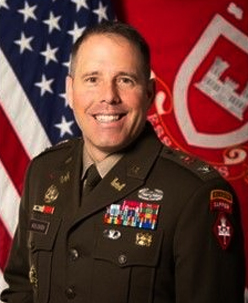Published on 03/04/2025
Colonel Stephen Kolouch
A Mandate to Transform
All of us must have the same sense of urgency about transforming our Army to meet the needs of our Nation. The good news is: I know we can do this together. We are serious about change. Talking about it is not enough. Warfighting is our number one priority. We have to do it as fast as we can.
—General Randy A. George, Chief of Staff of the Army1
As we appro
annual issue was created), we must look forward. Using our bulletin for this purpose is fitting, as communication within our Regiment is crucial in order for us to rise and meet the challenges that we face this year.
We inherit a world marked by competition, crisis, and global conflict. To even the casual observer, the character of conflict is changing rapidly; the current pace of change is spurred by the proliferation of unmanned aerial and ground systems, sensors, remote and autonomous systems, and electronic warfare. It is clear that those who learn and make decisions faster are better prepared than their foes in future combat. To the combatant, those who more quickly adapt to the changes are the ones who survive and prevail. But what do we choose to observe, how do we learn, and what decisions do we need to make? Today’s transparent battlefield, documented by myriad sensors and videos, offers abundant information. In fact, there is so much data available that it is more important than ever to sift through and discern what needs to be learned.
Our Regiment finds itself in an Army that is in a race to transform to meet current and emerging world threats. The Army considers this mission to be in continuous transformation along three time horizons:
- Near—transformation in contact.
- Mid—deliberate transformation.
- Far—concept-driven transformation.
As the Army is transforming, so too is the Engineer Regiment.
The Army approaches the 1-year mark of Transformation in Contact 1.0 having experimented with new capabilities and organizational concepts within three infantry brigade combat teams and publicly announcing its intent to expand this effort to armored brigade combat teams and Stryker brigade combat teams this year. Meanwhile, units such as the 20th Engineer Brigade, Fort Bragg, North Carolina, and the 36th Engineer Brigade, Fort Cavazos, Texas, are accelerating efforts in breaching and human-machine integration. USAES is advancing the Engineer Regiment, working closely with the capabilities development, acquisition, and test communities to sustain the capabilities that we rely on today and to develop the capabilities that we need for the future fight.
Although materiel is essential, it is important to understand that the Army is not just on a mission to buy new things. We must aggressively make changes across doctrine, organization, training, materiel, leadership and education, personnel, facilities, and policy (DOTMLPF-P). What works? What doesn’t work? What must we train? What should we invest in? What should inform doctrine? How should we organize? What should we stop doing?
To effectively observe, learn, and make decisions in this fast-paced world, the Engineer Regiment must leverage one of our greatest strengths—our network. We must discuss and share observations, lessons, and best practices to coherently move forward. We have engineers around the world who are engaged in being ready to fight today and transforming to fight in the future. We have engineers who are forward in theaters, conducting regionally aligned force deployments, training at combat training centers, experimenting with human-machine integrated formations, and participating in Transformation in Contact initiatives. We have engineers who conduct warfighter exercises and joint exercises and who interact with militaries from allied and partner nations. We have engineers who are assigned to schools—some as students and others as instructors, facilitating and observing Army-wide training events. And we are all paying attention to ongoing conflicts and observing the emergence of new technologies and the tactics used to employ them.
The work of collaboration has already begun. We created an Engineer Innovation Forum, and we host a monthly session attended by the school; units; and the capabilities development, research, and acquisition communities. Units are organized into areas of interest among our general, combat, and geospatial disciplines. And we anticipate significant engineer participation during the upcoming U.S. Army Futures Command Project Capstone Convergence 5, the Army’s signature experiment. But there is much more to be done. We must formalize our learning demands to work toward commonly understood goals. We must institutionalize necessary changes to our training and doctrine. And we need to ensure that Army National Guard and U.S. Army Reserve engineers are part of this effort.
If you are a leader in the Engineer Regiment, you are a part of this transformation. Please be an agent of change—not just a witness to it. Form your own opinions, share them, and defend them. Participate in the forums appropriate for your position, whether they be unit events or events sponsored by our Regiment. Write in order that your thoughts are recorded and not lost in the noise. Much of the conversation will be appropriate for an open audience. Engineer recently joined all other Army branch journals on the newly created Line of Departure website (<https://www.lineofdeparture.army.mil/>), which supports speedy publishing, mobile access, and audio versions of all articles.
We look forward to hosting Engineer Week 2025 at Fort Leonard Wood in April. Leaders will have ample opportunities to engage each other in conversation and move our Regiment forward. Come ready to participate!
Thank you to all engineer Soldiers, civilians, and Families.
Essayons!
Endnote:
1General Randy A. George, “Army Transformation Takes All of Us,” Association of the U.S. Army Annual Meeting and Exposition, 15 October 2025.




